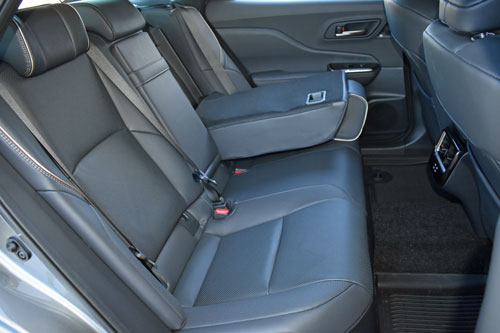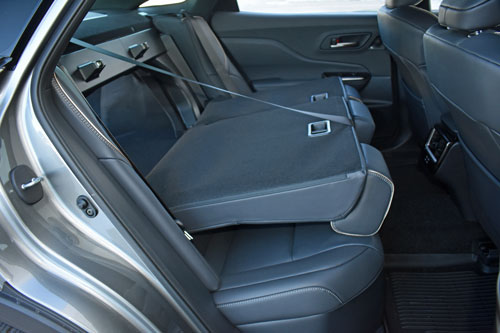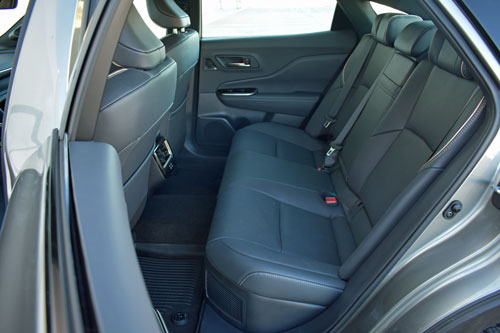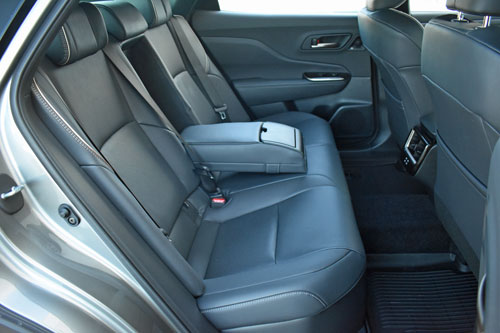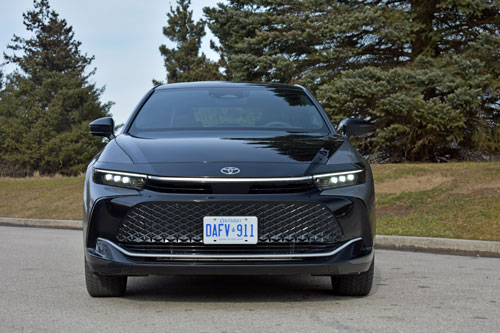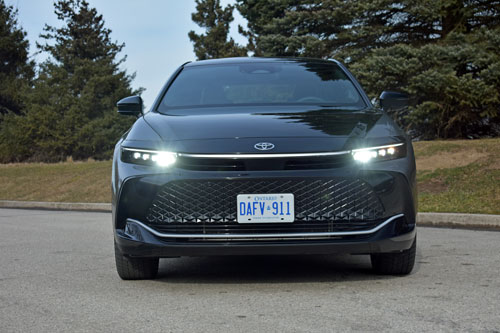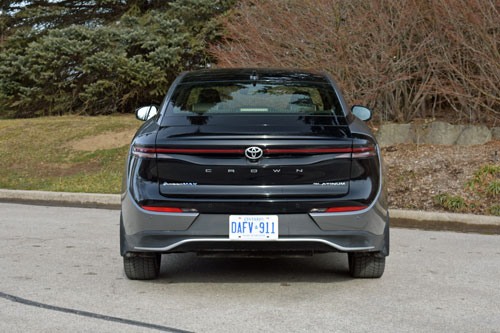The 2024 Toyota Crown is the sixteenth generation of that nameplate, but the first to hit our shores since the fourth-gen car was dropped some 50 years ago.
Like it has been pretty much since the nameplate’s intro even farther back that that, the Crown is a large-ish four-door sedan, although given North Americans’ distaste for that terminology, they are calling it a “Crossover”.
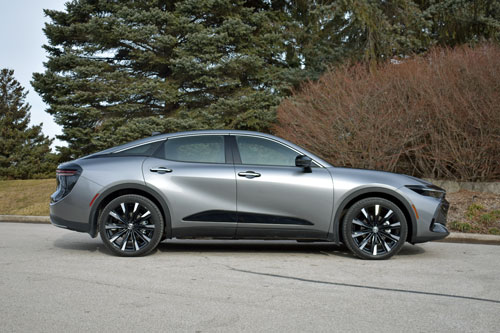
Hah. Looks like a duck, quacks like a duck, etc…
It’s a handsome beast, obviously styled by the wind tunnel, but with enough detailing, like a swoopy chrome-free front end and a matte-black “swoosh” on the body sides, to distinguish itself on the road.
Two variants are offered in Canada, both using versions of Toyota’s hybrid technology.
The “Limited” has a 2.5 litre four-cylinder twin-cam 16-valve engine with 222 horsepower, and a front-and-rear pair of motors adding 118 and 54 horses respectively.
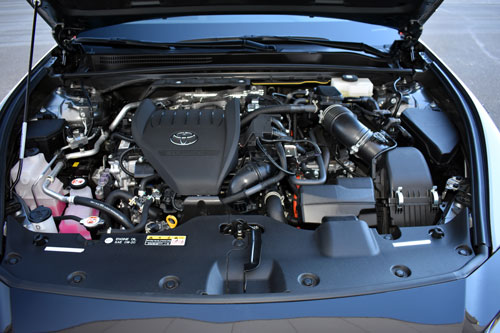
My “Platinum” tester had a similar configuration, but with the engine displacing 2.4 litres, and turbo-boosted to generate 264 horsepower at 6,000 rpm., and 332 lb-ft of torque between 2,000 and 3,000 rpm. The front-and-rear motors here bring 82 horsepower / 215 lb-ft and 79 hp / 124 lb-ft to the party, although for some reason Toyota prefers to refer to something called “net” horsepower of which this car has 340, without defining exactly what that number means.
This urge runs through a six-speed automatic transmission into a full-time four-wheel drive system which automatically delivers driving force to whichever axle can best utilize it. A gauge shows where the power is coming from (engine and/or motors) and to which axles it’s going. Why you need to know that remains an unanswered question.
There’s lots of room inside, partially thanks to the tallish roofline. The front seats are multiply adjustable, heated and cooled; the outboard rears are heated only.
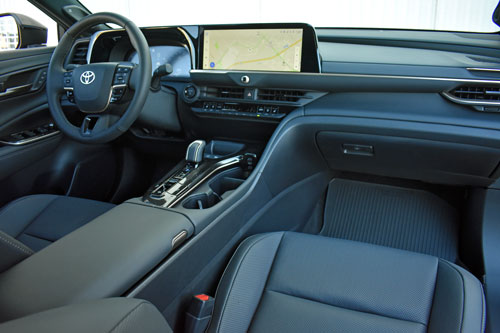
The ceiling is scooped away to offer more headroom for those confined to rear-seat purgatory. But those riders still have to put up with an odd seat shape. You sit very low back there, which I found uncomfortable. It looks like they have space to raise the seats; wonder why they didn’t?
The split-folding rear seat back increases luggage-carrying options, but the opening to the trunk is not very big, so it’s not as handy as it might be.
Seems odd that the extendable sun visors which are useful in early-morning or late-afternoon drives, and which were in the less expensive Camry I tested recently, are not offered on the pricier Crown.
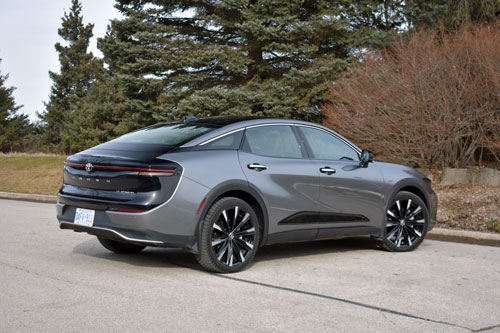
The interior trim is matte black, which is pretty much normal these days. All nicely finished as you would expect from Toyota.
Also, as usual these days, you will need several evenings with a pot of strong coffee to wade through the very detailed Owners Manual to figure out how to utilize the million options the dashboard offers. In the interest of journalistic completeness, I will attempt to summarize.
A control on left steering column stalk has buttons at the geographical coordinates (north, south, east, west) with an “OK” button in the middle. These allow you to page through the menus to get to the one you want, then wander through the dozen or more three- or four-letter acronyms which describe the various functions.
A “Return” button at the 10 o’clock position takes you back one step.
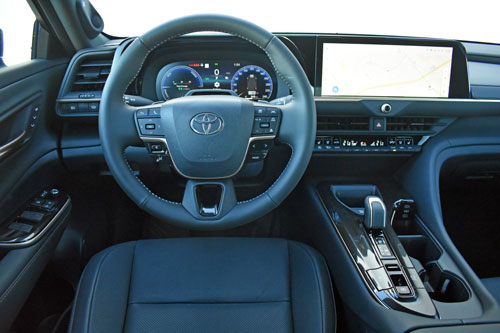
A similar control on the right steering column stalk controls “snooze-and-cruise”, which offers a lead-follow function. If traffic slows, the car automatically brakes, even to a full stop. Hit “Resume” and it returns to your preset speed. Almost hate to admit it, but I liked this.
Another modern feature I’m all over is the back-up camera because it tells me something I can’t see otherwise. Crown’s offers a bunch of different views to ease the reversing task.
Automatic parking? It’s offered, but again, I’ve had a bit of history with this feature, so no thanks.

Interestingly, a head-up display, another of my favourite targets, is not offered. Two cookies to Toyota for avoiding this distracting feature.
There are four USB-C plugs, two in front, two in rear. There is also one USB Type-A buried in the central cubby box behind the shifter, although that manual doesn’t seem to mention it.
That cubby box is hinged on both sides, making it easier for both front seat occupants to access it. There are other storage bins all over the place.
What looks like a square cup holder in front of the shifter is in fact a built-in charger for compatible cell phones. Mine, sadly, is not.
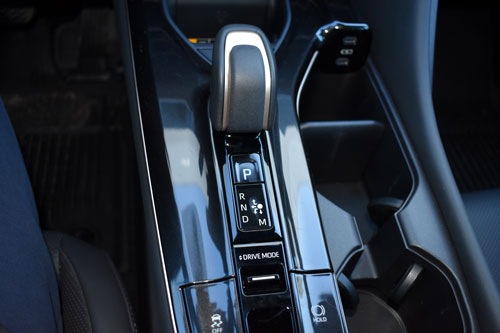
The dash features a speedometer on the right side, and another round gauge on the left which nominally shows “Charge/Eco/Power”, indicating that the car is charging the batteries, running on battery power, or using the engine. Again, you can swap gauges all over the place until you find the set-up you like.
A bar graph also gives you an indication of how much battery you have left, not that you can do much about it since this is not a plug-in hybrid.
My first task in every test car is to shut off all the nanny systems. I’d rather drive than be a passenger.

A full-on acceleration run will get you to 100 km/h in about 5.8 seconds. Not drag-strip-worthy, but fine for the purpose. And because the electric torque is available immediately, the car feels faster than that.
The transmission shifts unobtrusively, although the shifter needs work. Or just tossing it out and starting over. Let me explain:
It looks fairly normal. To get it out of Park, you first move the lever to the left, then back. This takes it directly to Drive, which sort of makes sense because that’s normally where you want to start. Except that’s not how about 99.9% of automatic transmission shifters have operated over the last 75 years, and there was no need to reinvent this particular wheel.
To select Reverse, you have to move it very slowly and deliberately forward from Drive, passing through Neutral.

If you pull the lever back from Neutral, you get “Manual” mode, but not really, since the transmission will downshift anyway under throttle inducement.
To get back to Drive from Manual, you have to shove it forward to Neutral, then back to Drive which again seems obtuse. It should just toggle back and forth.
To get back to Park, you don’t move the shift lever at all, just push on the “P” (park) button. Very confusing, with no apparent advantage. The fact that the Owners Manual contains no fewer than 8 1/2 pages of instructions on how to operate the “automatic” transmission suggests that Toyota knows this.
There are shift paddles as well for those who think they can shift better than the autobox.
The car is very quiet, thanks to lots of sound deadening; it’s hard to tell when the engine kicks in. It provides an excellent environment to enjoy the JBL 11-speaker sound system.
A “Drive Mode” switch offers several settings which adjust steering feel and effort, suspension stiffness, and transmission reaction to suit your driving style or your mood.
The default setting is “Normal”, although this word does not show up on the instrument panel.
The others setting names do and are more or less self-explanatory – “ECO”, “Comfort”, “Sport”, “Sport+”, and “Custom”. The latter lets you select individually from the offerings, instead of settling for one of the preset menus.
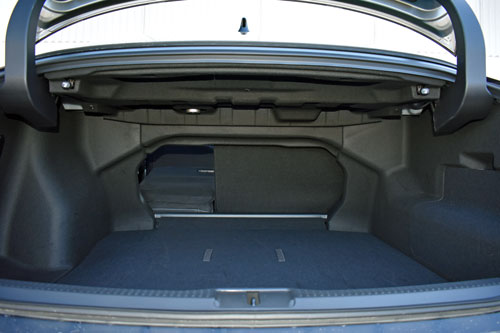
One thing you might notice in either Sport or Sport+, the engine idle shut-off does not appear to operate.
Among the key features included on the Premium trim level of Crown is “Adaptive Variable Suspension”, essentially variable-rate dampers allowing you to set their stiffness to “Comfort”, “Normal” or “Sport”. The differences as far as I could tell on our winter-pockmarked roads were slight, but worthwhile.
The result is a car that rides well, and despite steering feel that’s a bit vague, handles probably better than you’d expect in a luxury car from Toyota. The Michelin all-weather tires (my favourite tire brand) surely help here.
One of my pet peeves is SatNav that won’t allow you to chose “North Up”. The Crown lets you do so, but if you click on any other function on the screen then return to SatNav, it goes back to “Direction of Travel”. I thought maybe this was due to the settings for “My Driver” which allows each driver to set the car up the way they want it, but no – Toyota Canada says that this is the way it currently is, although I can’t imagine why they offer the “North Up” option but won’t let you save it. The mysteries of product planning…
The dashboard illumination goes dim when you go under a bridge. This is stupid because the car thinks it’s night-time when the full headlights are on, which of course they always should be, day or night. Also, like most new Toys I’ve driven, it beeps at you to turn your lights off when you leave the car but turns them off anyway after 30 seconds. Again people, why is there even a headlight switch?
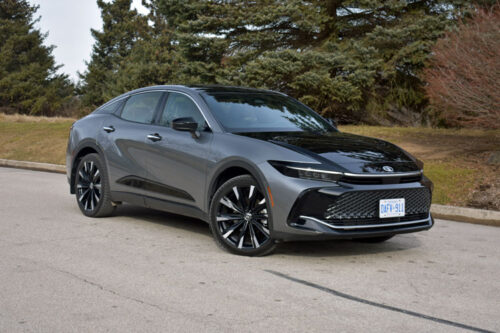
The hood is not counter-balanced, and once do you get the fiddly prop rod in place, it is VERY hard to get it out again. A minor quibble, but Toyota usually gets details like this right.
According to the web site, you pretty much choose the colour, because everything seems to be standard. Oh, and write a cheque for $64,682.58, plus taxes and various add-ons.
This is a fair amount of coin, but despite my few quibbles, Crown is a worthy contender in this space. Seems a bit odd that it’s not branded as a Lexus, but Toyota generally seems to know what they’re doing.
That font of all knowledge, Wikipedia (sometimes it is even correct), suggests that a station wagon version of this car will become available later this year. Dare I dream?
2024 Toyota Crown Platinum
Price as tested: MSRP $64,682.58
Configuration: transverse front-engine, automatic on-demand four-wheel drive
Engine: 2.4 litres, twin-cam 16-valve four cylinder turbocharged
Power/Torque: 264 horsepower/332 lb-ft
Twin electric motors, front – 82 horsepower / 215 lb-ft; rear and 79 hp / 124 lb-ft
Transmission: 6-speed automatic
Fuel consumption (litres per 100 km): 8.1 City, 7.3 Highway, 7.8 Combined
Warranty: Basic – 3 years/60,000 km; powertrain
Website: Toyota Canada





